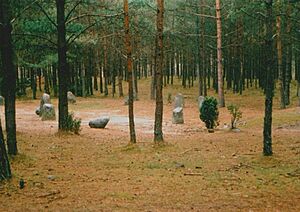Stone circle (Iron Age) facts for kids
Stone circles are special groups of stones arranged in a circle. They were a common way to bury people in southern Scandinavia during the Iron Age (around 500 BC to 400 AD). You can find many of them on the Swedish island of Gotland and in a region called Götaland.
In Sweden, these circles have cool names like Domarringar, Domkretsar, or Domarsäten. These all mean "judge circles" or "judge seats." It's important not to mix them up with the much older stone circles found in places like Britain, which were built during the Bronze Age.
Contents
History of Stone Circles
The idea of building stone circles also existed in other parts of Europe. For example, the Wielbark culture near the Vistula River in Poland made them around the first century. This might show that people from Scandinavia had an influence there.
These stone circles were often used as burial sites. People would bury their dead inside or near them.
What Do They Look Like?
Most stone circles are round, but some are shaped like long ovals, called ellipses. The stones themselves can be very big! Usually, there are between 9 and 12 stones in a circle. Sometimes there are fewer, like 6 to 8 stones.
One famous stone circle, called Nässja, near Vadstena in Sweden, has a lot more stones – 24 of them! When archaeologists dig around these circles, they often find burnt wood or coal in the middle. This tells us that people used to burn bodies there, making them a type of cremation grave.
What Were They Used For?
For a long time, people believed that stone circles were used for important meetings. These meetings were called "things" or "assemblies." They were places where people would gather to make decisions or settle arguments.
In Denmark, similar circles were used for public meetings until the 1500s. Even in a village called Vad in Sweden, people held their village meetings in a stone circle until the 1800s!
What Snorri Sturluson Said
Even though people later forgot that stone circles were graves, this knowledge was still around in the 1200s. A famous Icelandic writer named Snorri Sturluson wrote about it. In his book, the Heimskringla, he said:
As to funeral rites, the earliest age is called the Age of Burning; because all the dead were consumed by fire, and over their ashes were raised standing stones.
This quote tells us that people in the past knew these standing stones were put up over the ashes of the dead.
Famous Stone Circles
Here are some examples of stone circles you can find:
- Gettlinge burial field, Öland, Sweden
- Hulterstad burial field, Öland, Sweden
- Jelling stones, Vejle, Denmark
- Käräjämäki, Eura, Finland
- Käräjämäki, Kokemäki, Finland
- Liikistö, Ulvila, Finland
- Stoplesteinan, Norway
- Odry, Pomerania, Poland
- Węsiory burial field, Kashubia, Poland



